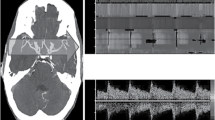Abstract
Transcranial Doppler systems have not been available for monitoring of cerebral blood flow velocities in neonates because of potential hazardous effects of energy output from standard instruments developed for adult application. Aim of the study was to test commercially available transcranial Doppler instruments for their applicabiltiy in neonates and to develop guidelines for adaptation for safe neonatal use. Energy output of five commercially available transcranial Doppler instruments was measured with a hydrophone system and a radiation force balance. At the highest setting and at the nominal 10% attenuation level, five out of five and two out of five instruments, respectively, had an energy output above the recommended limits. Power reduction was not linear in one instrument. Evaluation of safety devices (alarm, freeze mode, energy reduction facilities, display of energy values) showed that none of the tested instruments had an optimal setting for safe neonatal application.
Similar content being viewed by others
Abbreviations
- AIUM :
-
American Institute of Ultrasound in Medicine
- CBFV :
-
cerebral blood flow velocities
- I ob :
-
output beam intensity
- I SPTA :
-
spatial-peak temporal-average intensity
- p − :
-
peak-negative acoustic pressure
- P max :
-
maximum acoustic power
- TCD :
-
transcranial Doppler
References
Aaslid R, Markwalder TM, Nornes H (1982) Noninvasive transcranial Doppler ultrasound recording of flow velocity in basal cerebral arteries. J Neurosurg 57:769–774
Anthony MY, Evans DH, Levene MI (1991) Cyclical variations in cerebral blood flow velocity. Arch Dis Child 66:12–16
Antich PP (1993) Ultrasound study of bone in vitro. Calcif Tissue Int 53 [Suppl 1]:157–161
A.I.U.M. (1990) Safety considerations for diagnostic ultrasound. American Institute of Ultrasound in Medicine, Rockville Maryland
Bacon DR, Shaw A (1993) Experimental validation of predicted temperature rises in tissue-mimicking materials. Phys Med Biol UK 38: 1647–1659
Barnett SB, Kossoff G, Edwards MJ (1994) Is diagnostic ultrasound safe? Med J Aust 160: 33–37
Bode H, Urnmenhofer W, Frei F (1993) Effects of laryngoscopy and tracheal intubation on cerebral and systemic haemodynamics in children under different protocols of anaesthesia. Eur J Pediatr 152: 905–908
Burrows FA, Bissonnette BA (1993) Cerebral blood flow velocity patterns during cardiac surgery utilizing profound hypothermia with low-flow cardiopulmonary bypass or circulatory arrest in neonates and infants. Can J Anaesth 40: 298–307
Dagirmanjian A, Davis DA, Rothfus WE, Ziad LD, Goldberg AL (1993) Silent cerebral microemboli occurring during carotid angiography: frequency as determined with Doppler sonography. AJR 161: 1037–1040
Fenton A, Evans DH, Levene MI (1990) On line cerebral blood flow velocity and blood pressure measurement in neonates: a new method. Arch Dis Child 65: 11–14
Ferrarri FA, Kelsall WR, Rennie JM, Evans DH (1995) The relationship between cerebral blood flow velocity fluctuations and sleep state in normal newborns. Pediatr Res 35: 50–54
Filipczynski L, Kujawska T, Wojcik J (1993) Temperature elevation in focused Gaussian ultrasonic beams at various insonation times. Ultrasound Med Biol 19: 667–679
IEC 1157 (1992) Requirements for the declaration of acoustic output of medical diagnostic ultrasonic equipment. CEI Reference No. 1157
Ipsiroglu OS, Pessenhofer H, Netzbandt P, Kainer F, Weiss PAM, Rosegger H (1994) The influence of mode of delivery and resuscitation procedures on cerebral blood flow velocities of mature and immature newborns. In: Cosmi EV, DiRenzo GC (eds) Current progress in perinatal medicine. Parthenon Publishing, London, pp 887–892
Ipsiroglu OS, Steck J, Michel E, Pessenhofer H, Hahn T, Jorch G, Pollak A (1994) Is Transcranial (tc) Doppler sonography safe for neonates? Pediatr Res 36: 19A
Ipsiroglu OS, Kuhle S, Haxhija E, Weninger M, Michel E, Pessenhofer H, Pollak A (1995) Stereo measurements of cerebral blood flow velocities (CBFV) by transcranial Doppler sonography. Biol Neonate 67: 305–306
Ipsiroglu OS, Kuhle S, Haxhija E, Weninger M, Michel E, Pessenhofer H, Pollak A (1995) Spontaneous alterations of cerebral blood flow velocities in healthy term infants. Eur J Pediatr 154: 251
Jago JR, Henderson J, Whittingham TA, Willson K (1994) How reliable are manufacturer's reported acoustic output data. Ultrasound in Med Biol, 21: 135–136
Jorch G, Rabe H, Garbe M, Michel E, Gortner L (1989) Acute and protracted effects of intratracheal surfactant application on internal carotid blood flow velocity, blood pressure and carbon dioxide tension in very low birth weight infants. Eur J Pediatr 148: 770–773
Özek E, Köroglu TF, Karakok F, Kilic T, Tangören M, Pamir N, Basaran M, Bekiroglu N (1995) Transcranial Doppler assessment of cerebral blood flow velocity in term newborns. Eur J Pediatr 154: 60–63
Wu J, Du G (1990) Temperature elevation generated by a focused Gaussian beam of ultrasound. Ultrasound Med Biol 16: 489–498
Zernikov B, Michel E, Kohlmann G, Steck J, Schmitt RM, Jorch G (1994) Cerebral autoregulation of preterm neonates - a non-linear control system? Arch Dis Child 70: 166–17
Author information
Authors and Affiliations
Rights and permissions
About this article
Cite this article
Ipsiroglu, O.S., Steck, J., Michel, E. et al. Are adult transcranial Doppler systems suitable for application in neonates?. Eur J Pediatr 155, 942–947 (1996). https://doi.org/10.1007/BF02282884
Received:
Accepted:
Issue Date:
DOI: https://doi.org/10.1007/BF02282884




